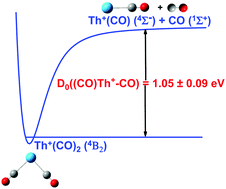Experimental and computational investigation of the bond energy of thorium dicarbonyl cation and theoretical elucidation of its isomerization mechanism to the thermodynamically most stable isomer, thorium oxide ketenylidene cation, OTh+CCO†
Abstract
Collision-induced dissociation (CID) of [Th,2C,2O]+ with Xe is performed using a guided ion beam tandem mass spectrometer (GIBMS). The only products observed are ThCO+ and Th+ by sequential loss of CO ligands. The experimental findings and theoretical calculations support that the structure of [Th,2C,2O]+ is the bent homoleptic thorium dicarbonyl cation, Th+(CO)2, having quartet spin, which is both thermodynamically and kinetically stable enough in the gas phase to be observed in our GIBMS instrument. Analysis of the kinetic energy-dependent cross sections for this CID reaction yields the first experimental determination of the bond dissociation energy (BDE) of (CO)Th+–CO at 0 K as 1.05 ± 0.09 eV. A theoretical BDE calculated at the CCSD(T) level with cc-pVXZ (X = T and Q) basis sets and a complete basis set (CBS) extrapolation is in very good agreement with the experimental result. Although the doublet spin bent thorium oxide ketenylidene cation, OTh+CCO, is calculated to be the most thermodynamically stable structure, it is not observed in our experiment where [Th,2C,2O]+ is formed by association of Th+ and CO in a direct current discharge flow tube (DC/FT) ion source. Potential energy profiles of both quartet and doublet spin are constructed to elucidate the isomerization mechanism of Th+(CO)2 to OTh+CCO. The failure to observe OTh+CCO is attributed to a barrier associated with C–C bond formation, which makes OTh+CCO kinetically inaccessible under our experimental conditions. Chemical bonding patterns in low-lying states of linear and bent Th+(CO)2 and OTh+CCO isomers are also investigated.



 Please wait while we load your content...
Please wait while we load your content...